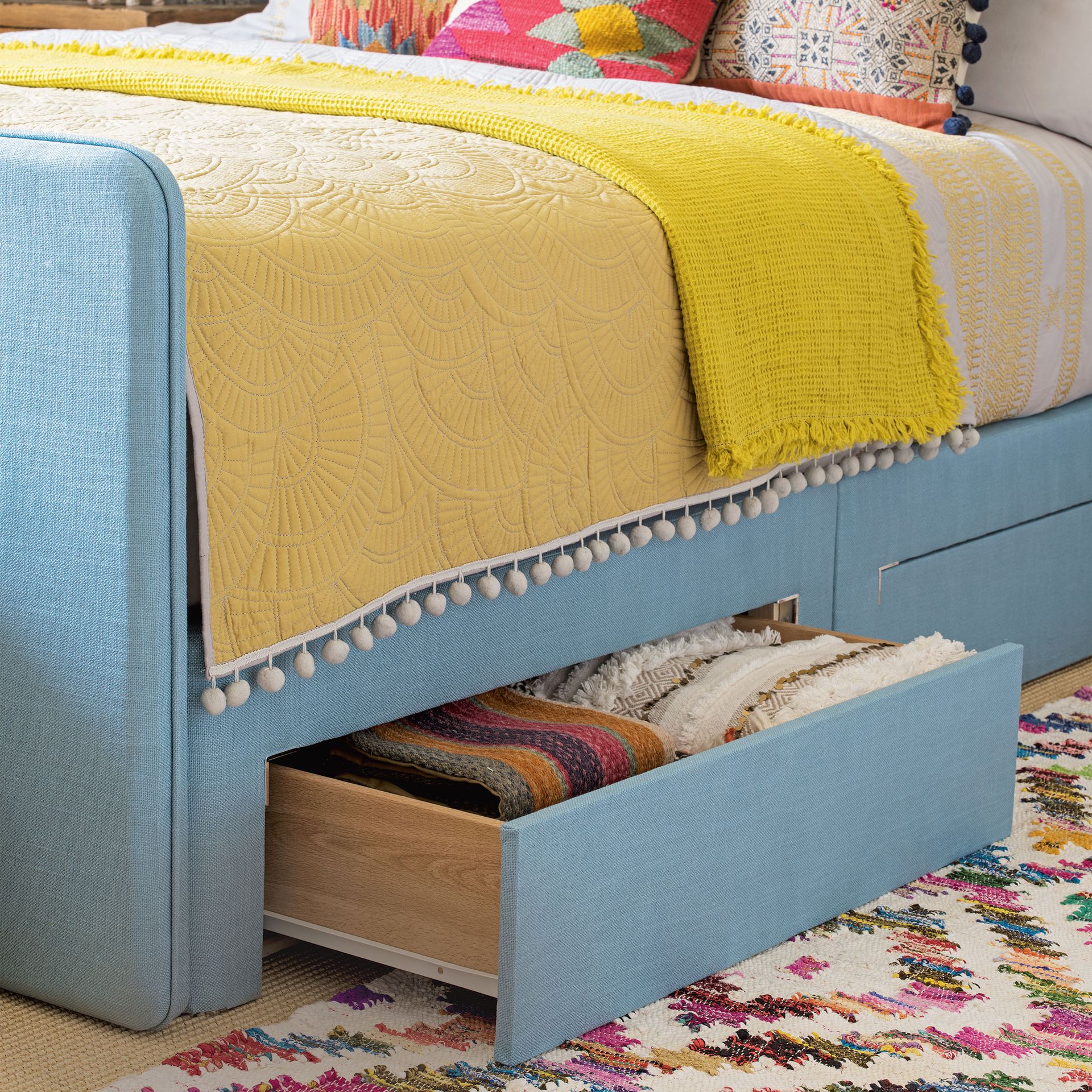How to get rid of bed bugs fast - how to spot and eradicate this unwanted pest
This simple guide on how to get rid of bed bugs will stop these invaders in their tracks and make sure they don’t come back

Sign up to our newsletter for style and decor inspiration, house makeovers, project advice and more.
Thank you for signing up to Ideal Home. You will receive a verification email shortly.
There was a problem. Please refresh the page and try again.
With recent reports that a bed bug epidemic is currently sweeping across the UK, it’s more important than ever to know how to rid your home of these pests. Bed bugs are no longer simply a bad memory from when you once stayed in a cheap youth hostel.
If you find yourself waking up with rows of red itchy bites, it’s important to understand how to banish these unpleasant house guests and stop the problem from getting any worse.
Discovering bed bugs in your home doesn’t mean that you have a dirty home, unfortunately, they can easily enter your property after a trip away when you unpack your luggage or if you’ve recently acquired some second-hand furniture. From there, they quickly multiply. And they don’t just stop at beds, they can quickly spread onto other soft furnishings, your sofa and other items of furniture.
Bed bugs are also common in multi-occupancy buildings, such as hotels and flats where they can easily spread from room to room by crawling through pipes and cracks in the walls.
How to get rid of bed bugs
If you discover you have a bed bug infestation, take action to eliminate them immediately. Contact your local council who may be able to help and treat your home for free. Or consult a pest control company that is a member of the British Pest Control Association because they will have experience removing stubborn bed bug infestations which may include insecticides to chemically kill them.
What are bed bugs?
Bed bugs are small oval and brownish insects that are similar in size and colour to an apple seed. They have flattened bodies which makes it easy for them to fit into tiny spaces and they like to live in groups in hiding places. They are parasites that consume human blood and can cause a number of health issues such as skin irritation and allergic reactions.
What kills bed bugs instantly?
The experts all concur that steam and particularly hot temperatures can instantly kill bed bugs.
‘Heat is highly effective at killing bed bugs,’ outlines Rex Isap, CEO and bed expert at Happy Beds. Washing any affected bedding or clothing at a high temperature of 60°C is key. Rex also recommends following this ‘by high-temperature drying in a tumble dryer if you have one.’
For items of furniture that you can’t simply pop in the washing machine, such as mattresses, sofas and chairs, ‘steaming will kill bed bugs if in direct contact,’ affirms Sophie Thorogood, Technical Training Manager at Pelsis Group.
‘However, refrain from doing this if you have a memory foam mattress as it won’t be able to withstand the heat,’ Rex warns.
‘Steam can kill bed bugs immediately. If you have a steamer, run this all over your bed, mattress, surrounding floor, and bedding. Apply the steam slowly and be sure to cover all of the folds and tufts of the bedding and mattresses. Also, be sure to get into all of the corners of the bed frame and edges where bed bugs may be hiding,’ says Robert Collins, pest control expert at MyJobQuote.co.uk.

The bites you get from bed bugs are usually on the parts of the body exposed while sleeping such as the head, arms and legs. The bites appear in clusters and come up as red raised bumps with a dark spot in the middle.
‘Although bed bugs typically feed on blood every 5 to 10 days, they are resilient and capable of surviving up to a year without feeding. Plus, female bed bugs lay 200-500 eggs over two months in batches of 10 to 50. The eggs are sticky and attach to items of furniture or fittings in clusters. Eggs can also hatch in about a week so it’s important to deal with a bed bug as soon as you find one,’ says Martin Seeley, the CEO and sleep expert at Mattress Next Day.
How to spot bedbugs
When you have a bed bug infestation a common sign is waking up with itchy areas on your skin which weren’t there when you went to bed. Also, look out for bloodstains on your sheets and pillowcases. Bedbugs release a very strong musty odour from their scent glands so pay attention to any unusual smells which could be a sign of their presence. While looking for bed bugs, pay attention to carpet beetles and how to get rid of them.

Sophie Thorogood, from Pelsis Group says, ‘Bed bugs are a particularly problematic pest both in terms of the issues they cause and their management. Although bed bugs are only 4-7mm long, they are easy to spot when out in the open. They can squeeze themselves into small gaps around bed frames, plug sockets, sofas, furniture and underneath the wallpaper.
‘Look carefully around these areas for signs of bed bugs including black spots which are the bed bugs’ faeces, this can be found on furniture surfaces and mattresses. A good inspection can indicate if you do have a problem and the extent of the infestation!
‘Bed bugs tend to enter homes through luggage and furniture. To prevent the pests from entering your home, if you’re away on a trip don’t place your luggage immediately on bedroom furniture. Instead, use the luggage racks with metal legs as bed bugs are unable to climb this.’
How to getting rid of bed bugs fast
We recommend getting professional help to get rid of bed bugs as these pests are notoriously hard to eradicate, due to their immunity to some household insecticides. Plus an infestation can easily recur if any eggs are missed, but if you want to try DIY pest control, follow these simple steps.
1. Spot the infestation

Completely strip your bed and put the infested bed linen, as well as pyjamas and soft toys straight into a 50°C - 60°C wash, if possible. Then tumble dry the items on the hottest setting for 30 minutes as the heat will kill any remaining bed bugs and their eggs. Placing bagged-up laundry in the freezer for three days will also kill the pests.
2. Clean the mattress

Clean your mattress every three months. 'Regularly cleaning your mattress is not only key to making it last longer but it’s also the perfect opportunity to check for bed bugs' advise experts at Mattress Next Day. 'You should aim to clean your mattress once every three months. Pocket sprung styles can be vacuumed safely, whereas foam styles like memory foam require sweeping to avoid damage.'
3. Inspect the surrounding area and vacuum

Dismantle your bed furniture and thoroughly inspect it along with your mattress and any other potential hiding places around the bed such as carpets, behind bedside tables and cracks in walls (which will need to be sealed) then use a vacuum cleaner with a plastic crevice nozzle attachment to suck up the bed bugs, including their eggs, larvae and droppings.
Throw away the vacuum cleaner bag and its contents in a sealed bin liner, immediately. A heavily-infested mattress will need to be disposed of safely and swapped for a new one.
4. Regularly air bedding

Bed bugs prefer to spend time in dirty environments so each week pull back the bedding and let your mattress air out. This allows your mattress to spring back into shape and allows any excess moisture to evaporate, which can attract bed bugs. Wash your bedding and sheets at least once a week to prevent the build-up of bacteria.
5. Check the whole house

The little pests can crawl quite far, so you should go over the whole room (if not your entire home) with a fine-toothed comb, looking under furniture, inside drawers, behind peeling wallpaper - everywhere, for signs of them.
6. Create you own chemical free spray

Tea tree oil can also be used as a natural bed bug insecticide - mix up your own spray, using 1 drop of tea tree oil to every fluid oz of water.
Steam cleaning is chemical free and instantly kills bed bugs and their eggs. We've tried and tested the best steam cleaners in the business to see which is best for the job at hand.
7. Keep your room cool – especially at night

According to the British Pest Control Association, the ideal temperature for an adult bed bug to thrive is between 21-32°C. So, keep your room cool at night-time. We have all the tips for ways to keep bedrooms cool.
8. Keep your home clutter free

Less clutter means less inviting hiding places. It also means your home will be easier to clean. The more objects you own, the more opportunities for bed bugs to hide. Plus, clutter increases the difficulty in eliminating bed bugs once they’ve been established.
9. Avoid cardboard storage solutions

Bed bugs are also known to hide in cardboard so if you have moved house unpack your boxes as quickly as possible. Use plastic storage containers rather than cardboard. Look for sustainable bedroom storage ideas that are that are sustainable and not inviting to bed bugs.
What to do if you're worried they'll come back?! Continue checking regularly for signs of returning bed bugs and treat any infested areas immediately, or call in the professionals if they keep coming back.
FAQS
What kills bedbugs naturally?
If you don’t wish to solely use chemicals to kill bedbugs there are natural solutions which can eliminate the pests and be used on top of natural cleaning hacks.
Robert Collins at MyJobQuote.co.uk says, ‘Diatomaceous earth is one of the best ways to get rid of bed bugs naturally. However, you can also wash your bedding, vacuum it, or freeze them out. These are all natural methods that may get rid of bedbugs. It’s usually best to use a few natural remedies as they are not always enough to eradicate the bed bugs completely on the first try.’
Diatomaceous earth is a fine powder that clings to the bodies of bed bugs and causes them to be dehydrated which leads to their deaths. Tea tree, lavender and peppermint oil are potent oils which when diluted with water can be sprayed onto areas where bed bugs are present. However, there is no single treatment that will eliminate a bed bug infestation, ideally, combine chemical and natural therapies and take precautions such as cleaning your surfaces thoroughly and washing your bedding in hot water.
Get the Ideal Home Newsletter
Sign up to our newsletter for style and decor inspiration, house makeovers, project advice and more.
Jennifer is the Deputy Editor (Digital) for Homes & Gardens online. Prior to her current position, she completed various short courses a KLC Design School, and wrote across sister brands Ideal Home, LivingEtc, 25 Beautiful Homes, Country Homes & Interiors, and Style at Home.
- Imani CottrellContent Editor
- Ellis CochraneContributor
-
 Aldi reveals it's opening 12 new stores in time for Christmas – is your city on the list?
Aldi reveals it's opening 12 new stores in time for Christmas – is your city on the list?Is your city on the list?
By Jullia Joson
-
 36 cosy living room ideas to create the ultimate snuggle-down spot
36 cosy living room ideas to create the ultimate snuggle-down spotAmp up the hygge levels with these cosy styles and expert advice
By Tamara Kelly
-
 How to plant hyacinth bulbs the right way for bright, healthy and beautiful blooms come spring
How to plant hyacinth bulbs the right way for bright, healthy and beautiful blooms come springGardening experts share their step-by-step guide to planting hyacinth bulbs
By Sara Hesikova


